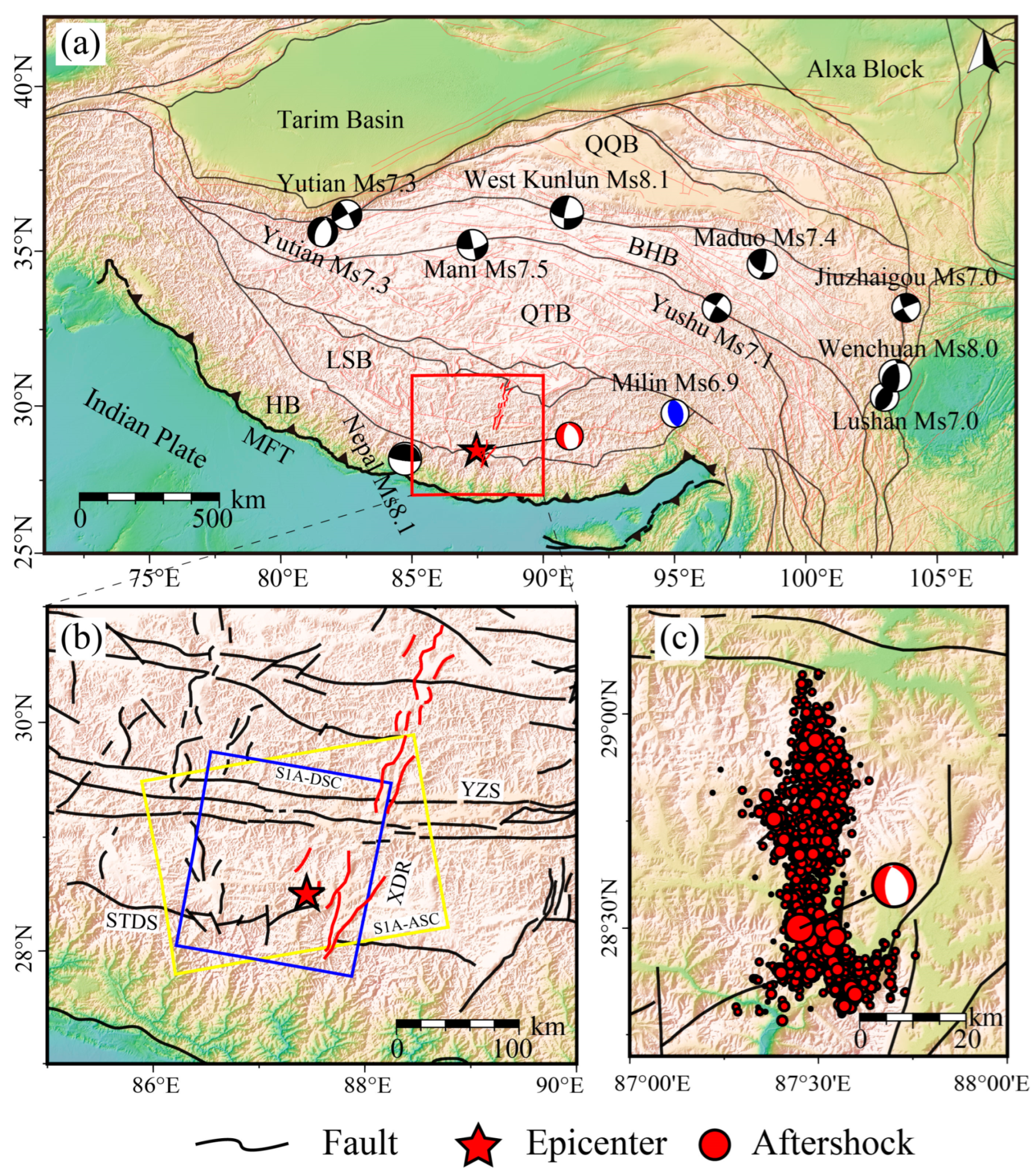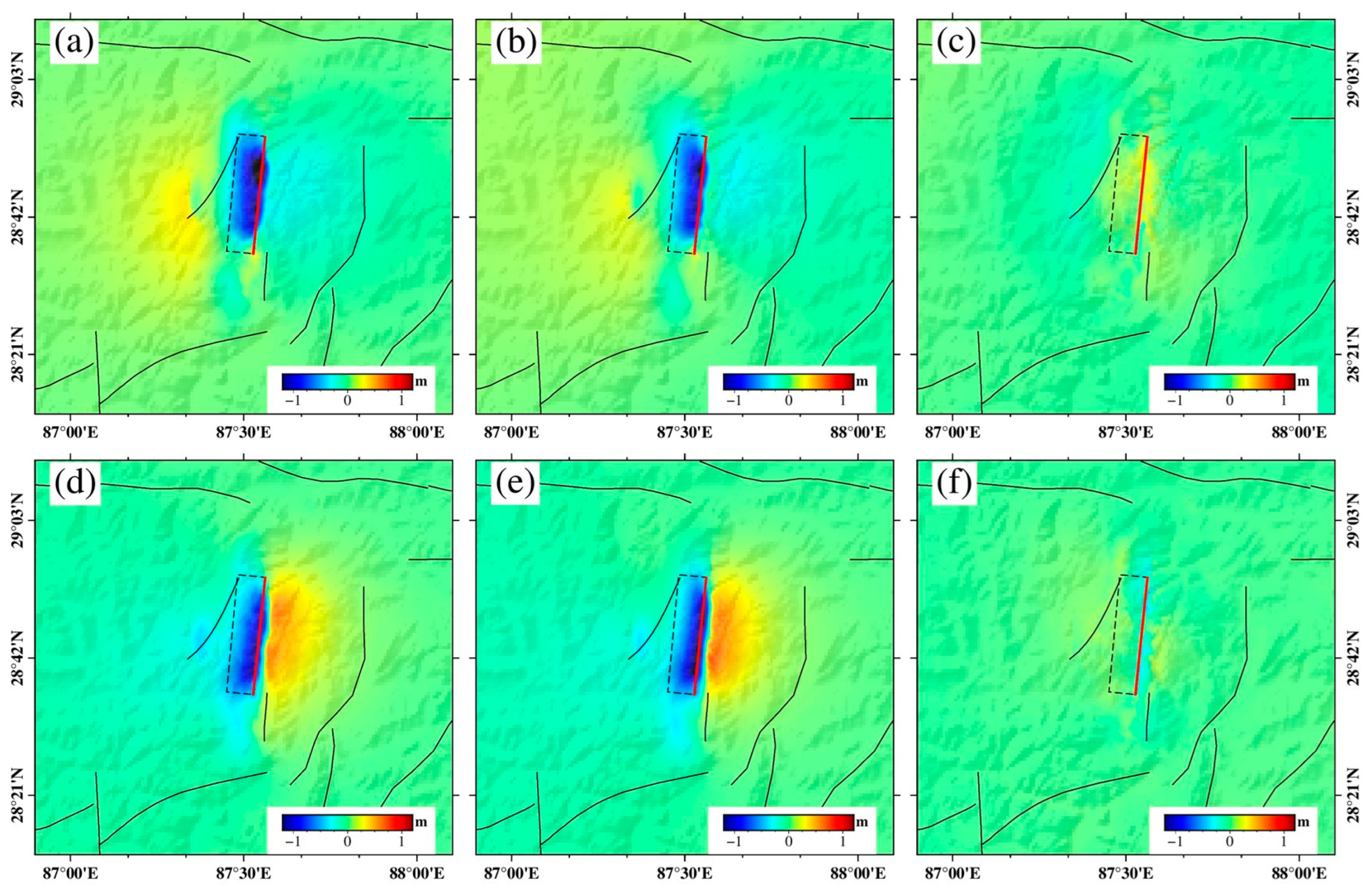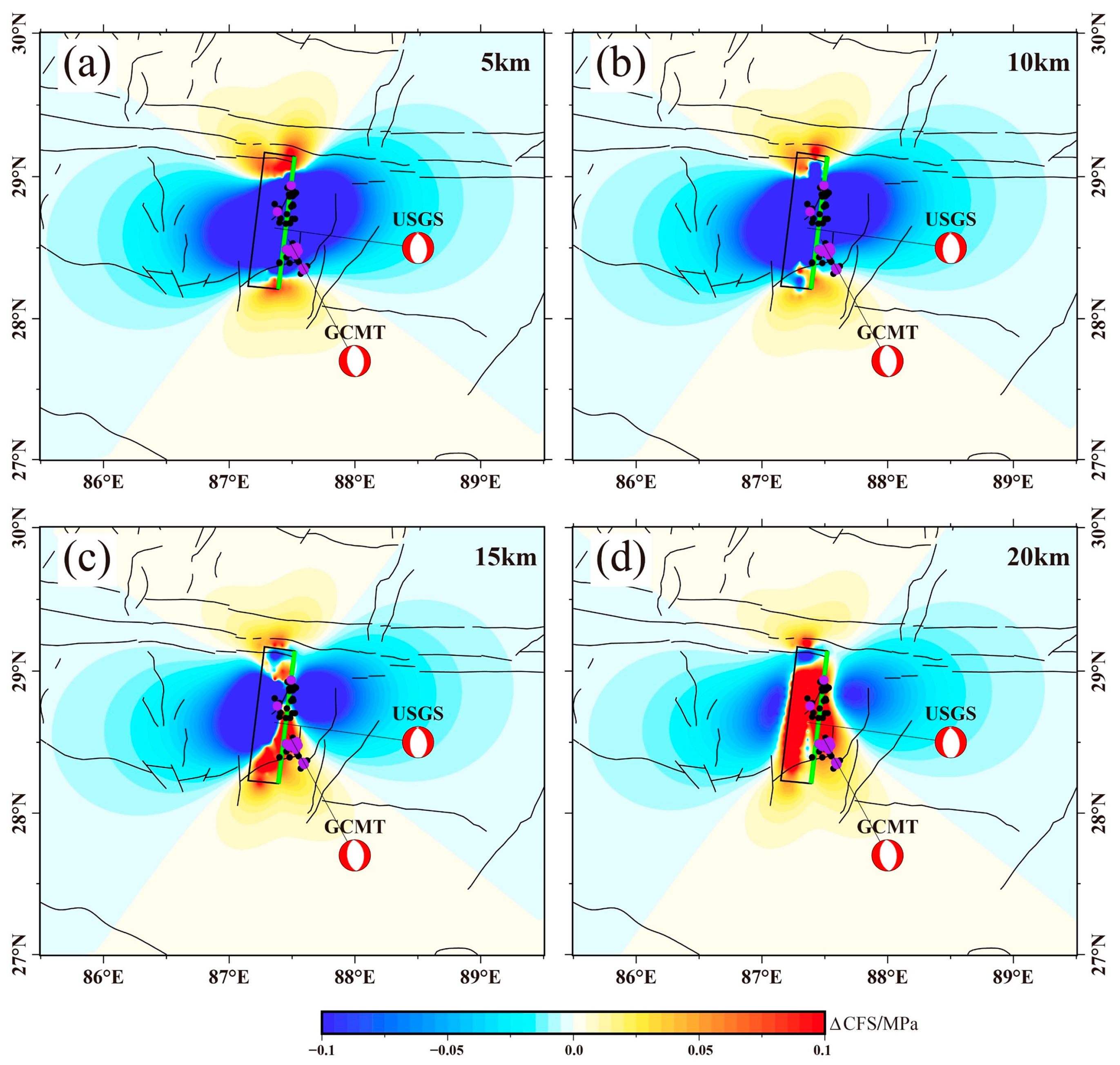Coseismic Deformation, Fault Slip Distribution, and Stress Changes of the 2025 MS 6.8 Dingri Earthquake from Sentinel-1A InSAR Observations
Abstract
1. Introduction
2. Materials and Methods
2.1. InSAR Data and Processing
2.2. Source Model Inversion and Coulomb Stress Analysis
3. Results
3.1. InSAR Coseismic Deformation
3.2. Inversion of Fault Geometry and Slip Distribution
3.2.1. Uniform-Slip Model
3.2.2. Distributed-Slip Model
3.3. Regional Stress Field Changes and Seismic Hazard Implications
4. Discussion
4.1. Methodological Advantage and Primary Findings
4.2. Comparison with the Conjugate Fault Model and Justification of Our Single-Fault Model
4.3. Seismic Hazard Implications and Stress Transfer
5. Conclusions
Author Contributions
Funding
Data Availability Statement
Acknowledgments
Conflicts of Interest
References
- Yang, T.; Wang, S.; Fang, L.; Wang, W.; Li, S.; Xu, G.; Tang, F. Analysis of Earthquake Sequence and Seismogenic Structure of the 2025 MS 6.8 Dingri Earthquake in the Tibetan Plateau. Earth Sci. 2025, 50, 1721–1732. [Google Scholar]
- Zhang, P.Z.; Shen, Z.; Wang, M.; Gan, W.; Bürgmann, R.; Molnar, P.; Wang, Q.; Niu, Z.; Sun, J.; Wu, J.; et al. Continuous Deformation of the Tibetan Plateau from Global Positioning System Data. Geology 2004, 32, 809–812. [Google Scholar] [CrossRef]
- Tapponnier, P.; Xu, Z.; Roger, F.; Meyer, B.; Arnaud, N.; Wittlinger, G.; Yang, J. Oblique Stepwise Rise and Growth of the Tibet Plateau. Science 2001, 294, 1671–1677. [Google Scholar] [CrossRef]
- Armijo, R.; Tapponnier, P.; Mercier, J.L.; Ha, T.L. Quaternary Extension in Southern Tibet: Field Observations and Tectonic Implications. J. Geophys. Res. Solid Earth 1986, 91, 13803–13872. [Google Scholar] [CrossRef]
- Bai, L.; Li, G.; Song, B. The Source Parameters of the M6.9 Mainling, Tibet Earthquake and Its Tectonic Implications. Chin. J. Geophys. 2017, 60, 4956–4963. [Google Scholar] [CrossRef]
- Zhang, X.M.; Du, G.B.; Liu, J.; Yang, Z.G.; Zou, L.Y.; Wu, X.Y. An M6.9 Earthquake at Mainling, Tibet on Nov. 18, 2017. Earth Planet. Phys. 2018, 2, 84–85. [Google Scholar] [CrossRef]
- Wang, S.; Replumaz, A.; Chevalier, M.; Li, H. Decoupling Between Upper Crustal Deformation of Southern Tibet and Underthrusting of Indian Lithosphere. Terra Nova 2022, 34, 62–71. [Google Scholar] [CrossRef]
- Shi, F.; Liang, M.; Luo, Q.; Qiao, J.; Zhang, D.; Wang, X.; Yi, W.; Zhang, J.; Zhang, Y.; Zhang, H. Seismogenic Fault and Coseismic Surface Deformation of the Dingri MS 6.8 Earthquake in Tibet, China. Seismol. Geol. 2025, 47, 1–15. [Google Scholar]
- Liang, M.; Dong, Y.; Zuo, H.; Dai, Y.; Xiao, B.; Liao, C.; Tan, L.; Wang, Y.; Li, X.; Tang, C.; et al. Surface Deformation Characteristics and Causes of the Dengmecuo Segment in the Xizang Dingri MS 6.8 Earthquake. Seismol. Geol. 2025, 47, 80–89. [Google Scholar]
- Bai, L.; Chen, Z.; Wang, S. The 2025 Dingri MS 6.8 Earthquake in Xizang: Analysis of Tectonic Background and Discussion of Source Characteristics. Rev. Geophys. Planet. Phys. 2025, 56, 258–263. [Google Scholar]
- Bai, Y.; Zhang, S.; Dong, Y.; Yang, Z.; Han, G. Characteristics of the Gravity Field and Faults in the Tingri–Muztagata Area, Xizang (Tibet) Plateau. Geol. Rev. 2012, 58, 237–249. [Google Scholar]
- Leloup, P.H.; Mahéo, G.; Arnaud, N.; Kali, E.; Boutonnet, E.; Liu, D.; Li, X.; Li, H. The South Tibet Detachment Shear Zone in the Dinggye Area: Time Constraints on Extrusion Models of the Himalayas. Earth Planet. Sci. Lett. 2010, 292, 1–16. [Google Scholar] [CrossRef]
- Tian, T.T.; Wu, Z.H. Recent Prehistoric Major Earthquake Event of Dingmucuo Normal Fault in the Southern Segment of the Shenzha–Dingjie Rift and Its Seismic Geological Significance. Geol. Rev. 2023, 69 (Suppl. S1), 53–55. [Google Scholar]
- Li, D.; Yang, B.; Chen, C. Obtaining Coseismic Deformation Field of the Jiuzhaigou Earthquake with Sentinel-1A Data. Remote Sens. Technol. Appl. 2018, 33, 1141–1148. [Google Scholar]
- Okada, Y. Surface Deformation Due to Shear and Tensile Faults in a Half-Space. Bull. Seismol. Soc. Am. 1985, 75, 1135–1154. [Google Scholar] [CrossRef]
- Massonnet, D.; Rossi, M.; Carmona, C.; Adragna, F.; Peltzer, G.; Feigl, K.; Rabaute, T. The Displacement Field of the Landers Earthquake Mapped by Radar Interferometry. Nature 1993, 364, 138–142. [Google Scholar] [CrossRef]
- Rosen, P.A.; Gurrola, E.; Sacco, G.F.; Zebker, H.A. The InSAR Scientific Computing Environment. In Proceedings of the 9th European Conference on Synthetic Aperture Radar (EUSAR 2012), Nuremberg, Germany, 23–26 April 2012; VDE: Berlin, Germany, 2012; pp. 730–733. [Google Scholar]
- Farr, T.G.; Rosen, P.A.; Caro, E.; Crippen, R.; Duren, R.; Hensley, S.; Kobrick, M.; Paller, M.; Rodriguez, E.; Roth, L.; et al. The Shuttle Radar Topography Mission. Rev. Geophys. 2007, 45, 1–33. [Google Scholar] [CrossRef]
- Weiss, J.R.; Walters, R.J.; Morishita, Y.; Wright, T.J.; Lazecky, M.; Wang, H.; Hussain, E.; Hooper, A.J.; Elliott, J.R.; Rollins, C.; et al. High-Resolution Surface Velocities and Strain for Anatolia from Sentinel-1 InSAR and GNSS Data. Geophys. Res. Lett. 2020, 47, e2020GL087376. [Google Scholar] [CrossRef]
- Goldstein, R.M. Atmospheric limitations to repeat-track radar interferometry. Geophys. Res. Lett. 1995, 22, 2517–2520. [Google Scholar] [CrossRef]
- Werner, C.; Wegmuller, U.; Strozzi, T.; Wiesmann, A. Processing strategies for phase unwrapping for InSAR applications. In Proceedings of the European Conference on Synthetic Aperture Radar (EUSAR 2002), Cologne, Germany, 4–6 June 2002. [Google Scholar]
- Yu, C.; Li, Z.; Penna, N.T.; Crippa, P. Generic atmospheric correction model for Interferometric Synthetic Aperture Radar observations. J. Geophys. Res. Solid Earth 2018, 123, 9202–9222. [Google Scholar] [CrossRef]
- Yu, C.; Li, Z.; Penna, N.T. Interferometric synthetic aperture radar atmospheric correction using a GPS-based iterative tropospheric decomposition model. Remote Sens. Environ. 2018, 204, 109–121. [Google Scholar] [CrossRef]
- Yu, C.; Penna, N.T.; Li, Z. Generation of real-time mode high-resolution water vapor fields from GPS observations. J. Geophys. Res. Atmos. 2017, 122, 2008–2025. [Google Scholar] [CrossRef]
- Jónsson, S.; Zebker, H.; Segall, P.; Amelung, F. Fault Slip Distribution of the 1999 Mw 7.1 Hector Mine, California, Earthquake, Estimated from Satellite Radar and GPS Measurements. Bull. Seismol. Soc. Am. 2002, 92, 1377–1389. [Google Scholar] [CrossRef]
- Marquardt, D.W. An Algorithm for Least-Squares Estimation of Non-Linear Parameters. J. Soc. Ind. Appl. Math. 1963, 11, 431–441. [Google Scholar] [CrossRef]
- Barbot, S.; Fialko, Y.; Bock, Y. Postseismic deformation due to the Mw 6.0 2004 Parkfield earthquake: Stress-driven creep on a fault with spatially variable rate-and-state friction parameters. J. Geophys. Res. 2009, 114, B07405. [Google Scholar] [CrossRef]
- Qiao, X.; Lu, Z.; Yan, S.; Shi, H.; Zhi, M.; Zhao, D. The 2025 MW 7.0 Dingri Earthquake: Conjugate Normal Faulting of a Graben Structure in the Southern Xainza-Dinggye Rift. Remote Sens. 2025, 52, e2025GL116154. [Google Scholar]







| Source | Lon/(°) | Lat/(°) | Strike/(°) | Dip/(°) | Rake/(°) | Magnitude |
|---|---|---|---|---|---|---|
| USGS | 87.47 | 28.56 | 356/173 | 42/48 | −88/−92 | MW 7.1 |
| GCMT | 87.36 | 28.64 | 349/187 | 42/49 | −103/−78 | MW 7.05 |
| GFZ | 87.41 | 28.57 | 0/164 | 49/41 | −79/−102 | MW 7.1 |
| IPGP | 87.36 | 28.64 | 341/196 | 51/44 | −113/−64 | MW 7.16 |
| CENC | 87.45 | 28.50 | 356.3/184.4 | 43.6/47.7 | −102.7/−78.1 | MW 7.0 |
| This study | 87.51 | 28.76 | 183.5 | 55.4 | −71.9 | MW 7.05 |
| Path | Date | Orbit Direction | Time(d) | Spatial Baseline (m) | Azimuth Angle (°) | Incidence Angle (°) |
|---|---|---|---|---|---|---|
| T121 | 2025/01/01 | Descend | 12 | −15.23 | −167.35 | 36.71 |
| 2025/01/13 | ||||||
| T12 | 2025/01/05 | Ascend | 12 | 53.24 | −12.65 | 39.49 |
| 2025/01/17 |
| Length/km | Width/km | Depth/km | Dip/(°) | Strike/(°) | Lon/(°) | Lat/(°) | Rake/(°) | Slip/m | |
|---|---|---|---|---|---|---|---|---|---|
| Best fit | 28.42 | 12.81 | 853.3 | 55.41 | 183.51 | 87.5153 | 28.7559 | −71.95 | 2.89 |
| mean | 28.43 | 12.84 | 861.9 | 55.35 | 183.50 | 87.5151 | 28.7557 | −71.14 | 2.92 |
| Std | 0.5 | 0.81 | 108.4 | 1.56 | 0.30 | 0.0033 | 0.0025 | 4.56 | 0.12 |
Disclaimer/Publisher’s Note: The statements, opinions and data contained in all publications are solely those of the individual author(s) and contributor(s) and not of MDPI and/or the editor(s). MDPI and/or the editor(s) disclaim responsibility for any injury to people or property resulting from any ideas, methods, instructions or products referred to in the content. |
© 2025 by the authors. Licensee MDPI, Basel, Switzerland. This article is an open access article distributed under the terms and conditions of the Creative Commons Attribution (CC BY) license (https://creativecommons.org/licenses/by/4.0/).
Share and Cite
Zhu, J.; Zhang, B.; Yao, S.; Cai, Y. Coseismic Deformation, Fault Slip Distribution, and Stress Changes of the 2025 MS 6.8 Dingri Earthquake from Sentinel-1A InSAR Observations. Geosciences 2025, 15, 421. https://doi.org/10.3390/geosciences15110421
Zhu J, Zhang B, Yao S, Cai Y. Coseismic Deformation, Fault Slip Distribution, and Stress Changes of the 2025 MS 6.8 Dingri Earthquake from Sentinel-1A InSAR Observations. Geosciences. 2025; 15(11):421. https://doi.org/10.3390/geosciences15110421
Chicago/Turabian StyleZhu, Junwen, Bo Zhang, Saisai Yao, and Yimeng Cai. 2025. "Coseismic Deformation, Fault Slip Distribution, and Stress Changes of the 2025 MS 6.8 Dingri Earthquake from Sentinel-1A InSAR Observations" Geosciences 15, no. 11: 421. https://doi.org/10.3390/geosciences15110421
APA StyleZhu, J., Zhang, B., Yao, S., & Cai, Y. (2025). Coseismic Deformation, Fault Slip Distribution, and Stress Changes of the 2025 MS 6.8 Dingri Earthquake from Sentinel-1A InSAR Observations. Geosciences, 15(11), 421. https://doi.org/10.3390/geosciences15110421





